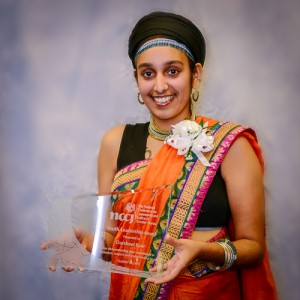Darsheel Kaur, a first-year graduate student at Eastern Mennonite University’s Center for Justice and Peacebuilding (CJP), has been awarded a Youth Humanitarian Award by the Greater Dayton, Ohio chapter of the National Conference for Community and Justice. She was among six recipients honored at an Oct. 26 ceremony at Sinclair Community College in Dayton.
Kaur drew upon the values of her Punjabi Sikh upbringing to critically examine her social environment, identify injustice, and respond with community-organized direct action following the death of a young black man in her community.
That death, her consequential activist work with the Ohio Student Association, and the questions that ensued led Kaur to her studies in conflict transformation at CJP. She hopes to better understand the historic and cultural narratives of her ancestral homeland and the United States, her role as an organizer, and then return to Dayton to continue enacting positive change.
Learning to ‘stand up’ from a young age

Born in England, Kaur immigrated to the United States as a child. In the aftermath of the Sept. 11, 2001, attacks, Kaur witnessed a powerful example of structural violence and injustice when “Sikhs and Muslims became targets of hate crimes around this country.” With values rooted in the Sikh faith, a faith which emphasizes one’s internal truth and staying resolute in the face of oppression – Kaur says her experience in the aftermath of 9/11 caused her to embrace the part of Sikhism’s core identity that is “standing up for the truth; standing up for justice.”
At Wright State University, Kaur majored in organizational leadership, minoring in youth and community engagement and Spanish. She joined the Occupy movement and racial justice organizations on campus. Kaur also tutored in public schools and homeless shelters, through which she saw the education system dealing with students of color in detrimental ways.
In the summer of 2014, Kaur traveled to Mississippi with 50 area youth to commemorate the “Freedom Summer” of 1964 – a journey that “reinvigorated my commitment to social justice,” Kaur explained. The intergenerational gathering “connected me to this lineage” of racial justice work.
Nearby shooting prompts sustained activism
Shortly thereafter, in a Walmart 10 minutes from Kaur’s childhood home, John Crawford III was shot and killed by police officers. Crawford was handling an unpackaged air rifle and talking on his cell phone, actions to which several customers did not react, according to a security video released later. However, one customer called 911, claiming Crawford was “walking around with a gun in the store … pointing it at people.” The police responded with force. (The customer later recanted this statement, as outlined here in this article from the London, U.K.-based Guardian, which illustrates the worldwide interest in the shooting.)
Kaur was instrumental in organizing the first of a series of demonstrations – a candlelight vigil and march – when authorities declined to release the security tapes of the shooting. After another rally in Columbus, the attorney general released the tapes to the Crawford family, which “showed us the power of collective action,” said Kaur.
Kaur and other organizers continued to organize rallies and demonstrations to pressure local officials for a thorough investigation and fair prosecution, resulting in a special prosecutor being appointed to the case.
In late September 2014, among other actions planned by the Ohio Student Association [Kaur speaks more about the march and her own activism in this Salon interview], she marched 11.5 miles from the Walmart to the site of grand jury proceedings to review the police officers’ actions. Around 80 people participated in the march. “The broader community really made that happen,” she said, acknowledging the volunteers who made available water, meals, rides for the weary, and rest areas.
After the grand jury declined to indict the officers, and the security tapes were released to the public, Kaur helped facilitate a community meeting to see the tapes, express grief, and brainstorm for future justice work. At an Ohio Student Association activist rally, Kaur and other community members presented the local police chief with demands for change. They then occupied the police station for three days, waiting to meet with the chief and discuss their requests. [Kaur is visible in this video interview after protesters met with the police chief.]
Pondering the form and shape of justice
Since then, conversations in the community and in Kaur’s head have revolved around concepts of justice.
“One killing is a symptom of a larger problem,” Kaur said. She helped start a regular community meeting to address the “deeper issues of safety, belonging and unfair distribution of resources” which breed a culture of violence.
In the wake of the grand jury’s decision not to indict the officers, “I really had to think about the concept of justice,” says Kaur.
No legal action would bring Crawford back to his family. As a prison abolitionist, Kaur did not believe incarcerating the police officers would address the deeper root problems. How, then, could positive change come about?
These questions led her to EMU to learn more about justice on a structural level, and how restorative justice can improve safety, opportunity and trauma healing for a community. After graduate school, she plans to return to Dayton and continue community development and organizing with an emphasis on engaging and empowering youth.
“It’s not just my responsibility to stand up for myself, but realize how I’ve been implicated in this racial hierarchy,” says Kaur.
